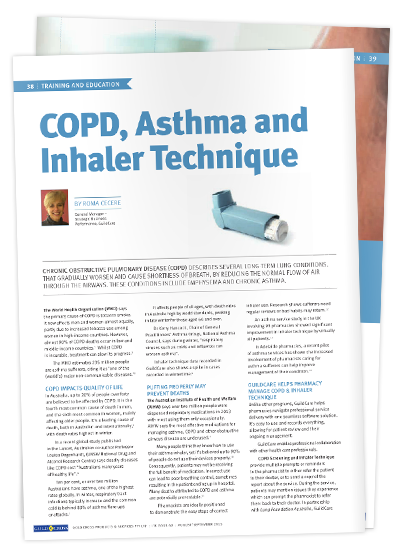Chronic Obstructive Pulmonary Disease (COPD) describes several long-term lung conditions, gradually worsening causing shortness of breath by reducing the normal flow of air through the airways. These conditions include emphysema and chronic asthma.
The World Health Organisation (WHO) says the primary cause of COPD is tobacco smoke. It now affects men and women almost equally, partly due to increased tobacco use among women in high-income countries. However, almost 90% of COPD deaths occur in low and middle-income countries . Whilst COPD is incurable, treatment can slow its progress.
WHO estimates 235 million people are asthma sufferers, citing it as ‘ one of the (world’s) major non-communicable diseases.’
COPD IMPACTS QUALITY OF LIFE
In Australia, up to 20% of people over forty are believed to be affected by COPD. It is the fourth most common cause of death in men, and sixth most common in women. COPD mainly affects older people. It’s a leading cause of death both in Australia and internationally , with death rates highest in winter.
In a recent global study published in the Lancet, Australian co-author Professor Louisa Degenhardt, (UNSW National Drug and Alcohol Research Centre) says deadly diseases like COPD cost “Australians many years of healthy life”
Ten per cent or over two million Australians have asthma, one of the highest rates globally. In winter, respiratory tract infections typically increase and the common cold is behind 80% of asthma flare-ups or attacks .
It affects people of all ages, with death rates in Australia high by world standards, peaking in late winter for those aged 64 and over.
Dr Kerry Hancock, Chair of General Practitioners’ Asthma Group , National Asthma Council, says during winter “Respiratory viruses such as colds and influenza can worsen asthma.” Inhaler technique data recorded in GuildCare also shows a spike in cases recorded in wintertime .
PUFFING PROPERLY MAY PREVENT DEATHS
The Australian Institute of Health and Welfare (AIHW) says over two million people were dispensed respiratory medications in 2013. Most used them only occasionally. AIHW says the most effective medications for managing asthma, COPD and other obstructive airways disease are underused .
Many people think they know how to use their asthma inhaler. Yet it’s believed up to 90% of people do not use their devices properly . Consequently, patients may not be receiving the full benefit of medication. Incorrect use can lead to poor breathing control. Sometimes the patient ends up in hospital. Many deaths attributed to COPD and asthma are potentially preventable .
Pharmacists are ideally positioned to demonstrate the easy steps of correct inhaler use. Research shows sufferers need regular reviews or bad habits may return . An asthma service study in the UK involving 93 pharmacies showed significant improvement in inhaler technique by virtually all patients . In Adelaide pharmacies, a recent pilot of asthma services has shown the increased involvement of pharmacists in caring for asthma sufferers can help improve management of their condition’
GUILDCARE HELPS PHARMACY MANAGE COPD & INHALER TECHNIQUE
Unlike other programs, GuildCare helps pharmacies navigate professional service delivery with one seamless software solution. It ’s easy to use, records everything, allowing for patient review and their ongoing management.
GuildCare enables professional collaboration with other health care professionals.
COPD Screening and Inhaler Technique provide multiple prompts or reminders to the pharmacist to either refer the patient to their doctor, or to send a copy of the report about the service. During the service, patients may mention issues they experience which can prompt the pharmacist to refer them back to their doctor.In partnership with Lung Foundation Australia, GuildCare helps pharmacists perform and document the steps required for COPD screening. These include identifying patients eligible for screening, populating patient information, measuring spirometry using PIKO-6 or COPD-6, recording and interpreting the results of measurements. GuildCare prompts at point of dispense to suggest patients who may be eligible. Alternatively, patients can be enrolled ad-hoc. GuildCare's Inhaler Technique Check was developed in collaboration with National Asthma Council Australia. It assists pharmacists in assessing patient inhaler technique. The check identifies, corrects and documents any issues in technique to improve asthma control. It prompts to suggest potential patients at point of dispense and allows for ad-hoc enrolment of patients using over the counter inhalers. A printout is also provided for the patient. Videos demonstrating correct inhaler technique for different types of inhalers are easily accessible in GuildCare. Nicole Floyd is the Queensland Pharmacy Guild’s Professional Services and QCPP Manager. At Asthma Australia's May Conference, Nicole presented on the role community pharmacy can play in reviewing inhaler technique. She demonstrated GuildCare’s Inhaler Technique Check, telling attendees “best results are achieved by ensuring staff are well trained.” WHAT SUPPORT IS AVAILABLE?
The GuildCare Support Team can assist with any questions you have in becoming a subscriber. Training and technical suppurt is also available. Simpply email support@guildcare.com.au or call 1300 64 7 492 (8.30 am - 7pm AEDT weekdays). Feel free to visit our website at www.guildcare.com.au. | 

